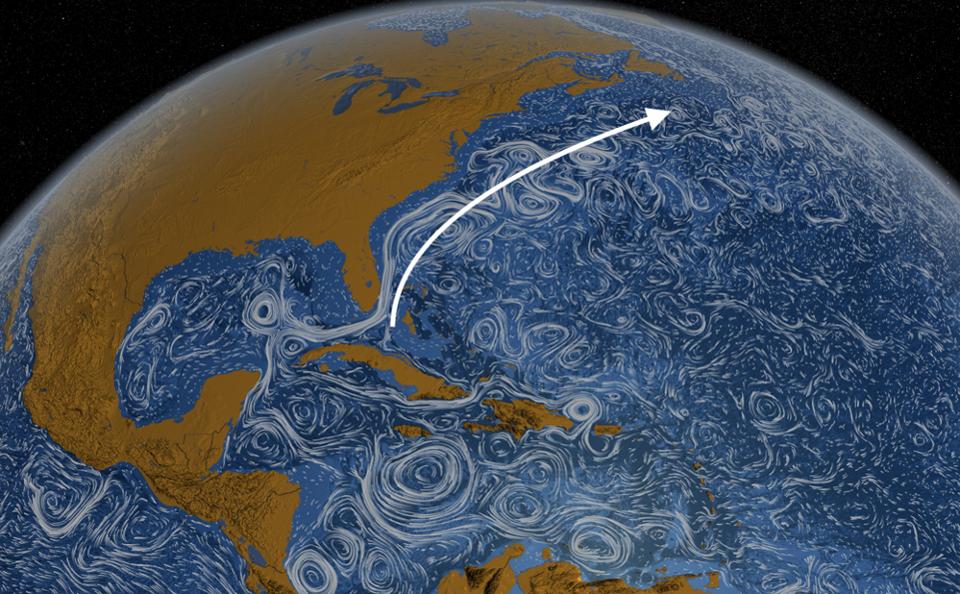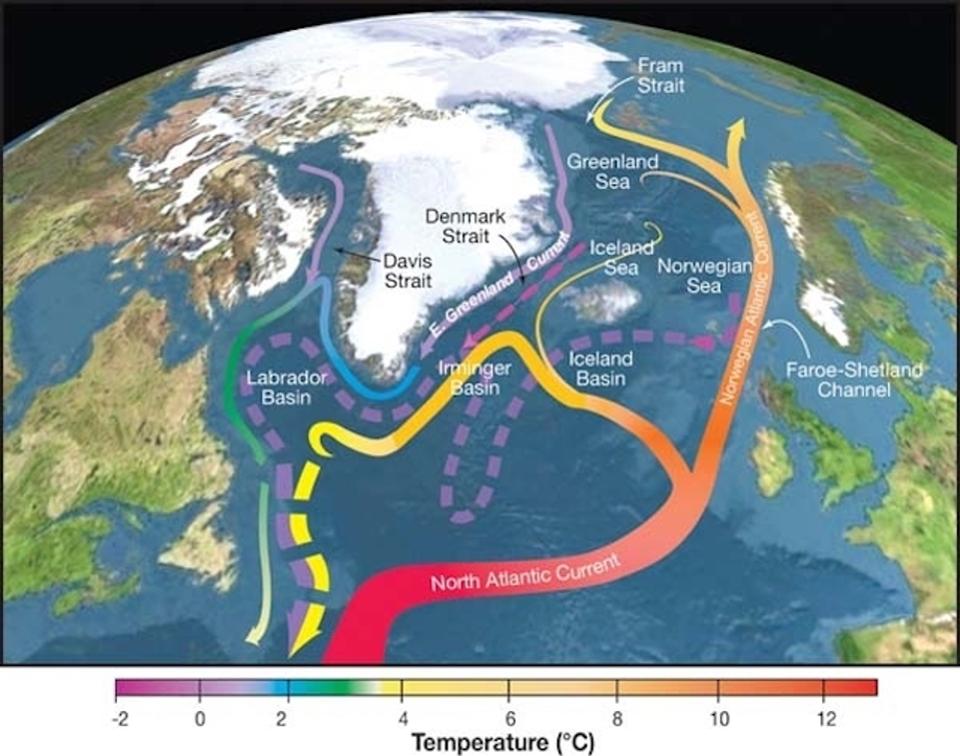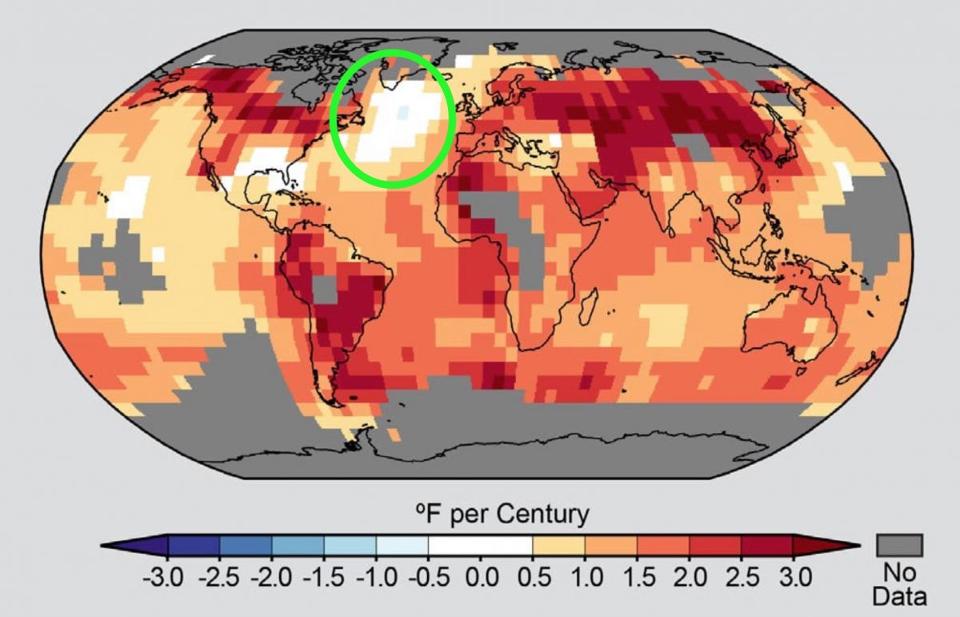Global Ocean Circulation Appears to Be Collapsing Due to a Warming Planet
ENVIRONMENT, 7 Aug 2017
3 Aug 2017 – Scientists have long known about the anomalous “warming hole” in the North Atlantic Ocean, an area immune to warming of Earth’s oceans. This cool zone in the North Atlantic Ocean appears to be associated with a slowdown in the Atlantic Meridional Overturning Circulation (AMOC), one of the key drivers in global ocean circulation.
A recent study published in Nature outlines research by a team of Yale University and University of Southampton scientists. The team found evidence that Arctic ice loss is potentially negatively impacting the planet’s largest ocean circulation system. While scientists do have some analogs as to how this may impact the world, we will be largely in uncharted territory.
AMOC is one of the largest current systems in the Atlantic Ocean and the world. Generally speaking, it transports warm and salty water northward from the tropics to South and East of Greenland. This warm water cools to ambient water temperature then sinks as it is saltier and thus denser than the relatively more fresh surrounding water. The dense mass of water sinks to the base of the North Atlantic Ocean and is pushed south along the abyss of the Atlantic Ocean.
This process whereby water is transported into the Northern Atlantic Ocean acts to distribute ocean water globally. What’s more important, and the basis for concern of many scientists is this mechanism is one of the most efficient ways Earth transports heat from the tropics to the northern latitudes. The warm water transported from the tropics to the North Atlantic releases heat to the atmosphere, playing a key role in warming of western Europe. You likely have heard of one of the more popular components of the AMOC, the Gulf Stream which brings warm tropical water to the western coasts of Europe.
Evidence is growing that the comparatively cold zone within the Northern Atlantic could be due to a slowdown of this global ocean water circulation. Hence, a slowdown in the planet’s ability to transfer heat from the tropics to the northern latitudes. The cold zone could be due to melting of ice in the Arctic and Greenland. This would cause a cold fresh water cap over the North Atlantic, inhibiting sinking of salty tropical waters. This would in effect slow down the global circulation and hinder the transport of warm tropical waters north.
Melting of the Arctic sea ice has rapidly increased in the recent decades. Satellite image records indicate that September Arctic sea ice is 30% less today than it was in 1979. This trend of increased sea ice melting during summer months does not appear to be slowing. Hence, indications are that we will see a continued weakening of the global ocean circulation system.
This scenario of a collapse in AMOC and global ocean circulation is the premise for the movie “The Day After Tomorrow.” As a disclaimer, the plot line in which much of New England and Western Europe gets plunged into an ice age is significantly over exaggerated and unrealistic on human time scales.
While geologists have studied events in the past similar to what appears to be happening today, scientists are largely unsure of what lies ahead.
______________________________________
Trevor Nace is a geologist, Forbes contributor, founder of Science Trends, and adventurer. Follow his journey @trevornace
DISCLAIMER: The statements, views and opinions expressed in pieces republished here are solely those of the authors and do not necessarily represent those of TMS. In accordance with title 17 U.S.C. section 107, this material is distributed without profit to those who have expressed a prior interest in receiving the included information for research and educational purposes. TMS has no affiliation whatsoever with the originator of this article nor is TMS endorsed or sponsored by the originator. “GO TO ORIGINAL” links are provided as a convenience to our readers and allow for verification of authenticity. However, as originating pages are often updated by their originating host sites, the versions posted may not match the versions our readers view when clicking the “GO TO ORIGINAL” links. This site contains copyrighted material the use of which has not always been specifically authorized by the copyright owner. We are making such material available in our efforts to advance understanding of environmental, political, human rights, economic, democracy, scientific, and social justice issues, etc. We believe this constitutes a ‘fair use’ of any such copyrighted material as provided for in section 107 of the US Copyright Law. In accordance with Title 17 U.S.C. Section 107, the material on this site is distributed without profit to those who have expressed a prior interest in receiving the included information for research and educational purposes. For more information go to: http://www.law.cornell.edu/uscode/17/107.shtml. If you wish to use copyrighted material from this site for purposes of your own that go beyond ‘fair use’, you must obtain permission from the copyright owner.


